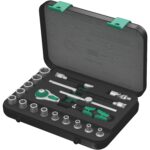In today’s automotive landscape, understanding your vehicle’s health and performance is becoming increasingly essential. Modern cars are complex machines, filled with sensors and computers monitoring every aspect of their operation. Fortunately, accessing this wealth of data is easier than ever with the help of an Obd-ii Car Scanner Tool. These powerful devices, once exclusive to professional mechanics, are now readily available to car owners, empowering them to diagnose issues, monitor performance, and potentially save money on repairs.
What is an OBD-II Car Scanner Tool?
OBD-II, or On-Board Diagnostics II, is a standardized system implemented in most vehicles manufactured after 1996. This system is designed to monitor various vehicle parameters, from engine performance to emissions, and report any detected issues. An obd-ii car scanner tool is an electronic device that connects to your car’s OBD-II port – typically located under the dashboard – and retrieves this diagnostic information. These tools range from simple code readers that display basic fault codes to sophisticated scanners with advanced features for in-depth analysis.
Key Features of a Modern OBD-II Car Scanner Tool
A quality obd-ii car scanner tool offers a wide array of functionalities that can benefit any car owner. Here are some key features to look for:
Real-time Data and Custom Dashboards
Imagine viewing your car’s vital signs in real-time on your smartphone. Advanced obd-ii car scanner tools can display live data from your vehicle’s sensors, including engine speed (RPM), coolant temperature, vehicle speed, fuel trim, and much more. Furthermore, many apps allow you to create custom dashboards, arranging gauges and charts to display the specific data points that are most important to you. This real-time insight is invaluable for performance monitoring and understanding how your car is behaving under different driving conditions.
Diagnostic Trouble Codes (DTCs) and Resetting
One of the most crucial functions of an obd-ii car scanner tool is its ability to read Diagnostic Trouble Codes (DTCs). When your car’s computer detects a problem, it stores a DTC, often illuminating the “check engine” light. A scanner tool can retrieve these codes, providing you with a starting point for diagnosis. Many tools also include a database of DTC descriptions, helping you understand what the code means. Furthermore, after addressing the issue, you can often use the scanner to reset the DTC and turn off the “check engine” light.
Extended PIDs for Deeper Insights
For enthusiasts and those seeking more in-depth information, some obd-ii car scanner tools support extended Parameter IDs (PIDs). Car manufacturers often have proprietary PIDs that go beyond the standard OBD-II parameters. A scanner with extended PID support can unlock access to this hidden data, providing even more detailed insights into your vehicle’s operation. This can be particularly useful for diagnosing complex issues or fine-tuning performance.
Emissions Readiness Check
Before emission testing, it’s beneficial to ensure your vehicle is ready. An obd-ii car scanner tool can perform an emissions readiness check, verifying that your car’s emission control systems have completed their self-tests and are functioning correctly. This can save you time and potential headaches at the testing station.
Comprehensive Sensor Monitoring
Beyond specific fault codes, an obd-ii car scanner tool allows you to monitor the health and readings of various sensors throughout your vehicle. This comprehensive sensor view can help you identify potential problems before they escalate into major issues. By observing sensor data, you can detect irregularities and proactively address maintenance needs.
Performance Measurement and Trip Computer
Many advanced obd-ii car scanner tools include performance measurement features, allowing you to accurately measure metrics like acceleration (0-60 mph, 0-100 km/h) and braking performance. Some apps also function as trip computers, providing statistics on fuel consumption, distance traveled, and average speed, making them useful for both performance enthusiasts and everyday drivers looking to optimize fuel efficiency.
Advanced Features for Specific Car Brands
Certain obd-ii car scanner tools offer specialized features for specific vehicle brands. For example, some scanners provide coding and adaptation functions for VAG group vehicles (Volkswagen, Audi, Skoda, Seat), allowing users to customize vehicle settings and unlock hidden features. If you own a vehicle from a specific manufacturer, it’s worth exploring scanners that offer enhanced support for your brand.
Choosing the Right OBD-II Scanner Tool and Adapter
To use an obd-ii car scanner tool app on your smartphone or tablet, you’ll need an OBD-II adapter that plugs into your car’s diagnostic port and communicates wirelessly via Wi-Fi or Bluetooth. ELM327-compatible adapters are widely used and supported by many scanner apps.
While budget-friendly ELM327 adapters are available, it’s important to be aware of potential quality issues. Some cheap Chinese clones, particularly those marked as v2.1, may have connectivity problems, provide unreliable data, or even interfere with your car’s electronics. For optimal performance and reliability, consider reputable adapter brands such as Kiwi 3, Viecar, V-Gate, Carista, LELink, or Veepeak. Investing in a quality adapter ensures a stable connection and accurate data retrieval, leading to a better overall experience with your obd-ii car scanner tool.
Conclusion
An obd-ii car scanner tool is an invaluable asset for modern car owners. Whether you’re a seasoned automotive enthusiast or simply want to stay informed about your vehicle’s condition, these tools offer a wealth of diagnostic and performance data right at your fingertips. By choosing the right scanner and adapter, you can unlock your car’s secrets, proactively address maintenance needs, and enjoy a more informed and empowered car ownership experience.

